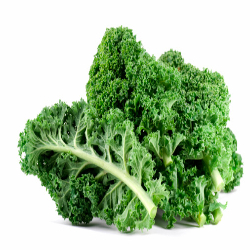Kale Nutrition facts
Kale

Kale or borecole in one of a kind, nutritious leafy greens that are rich in numerous health benefiting polyphenolic flavonoid compounds such as lutein, zeaxanthin, and β -carotene, and vitamins. It is widely cultivated in the Europe, Japan, and the United States for its crispy, “frilly“ leaves.
Botanically, the plant belongs to the “cabbage” (Brassica) family, in the subgroup of Brassica oleracea (acephala group). It characteristically has headless cabbage-like leafy greens. Other common vegetables in this family are broccoli, cauliflower, brussels sprouts, etc.
Kale is an annual plant that prefers well in rich organic soil and prefers a cooler climate and light frosting conditions to flourish. Its succulent, curly leaves feature “rosette” pattern and may have dark green to blue-green color depending on the cultivar type. In growth and appearance, it closely resembles collard greens. Farmers plan the crop, particularly keeping in mind for autumn and winter harvest, since frost, and cold weather conditions help in better yield and further enhances its flavor.
Some of the important cultivars grown around are -Scottish curly leaf (Brassica napus (Pabularia Group)), Red Russian, Blue curled, Winterbor.
Tuscan kale, also known as cavalo nero or lacinato kale, is a popular winter-season green in the Northern parts of Italy. It features distinctive very long, curly, blue-green leaves with an embossed surface resembling like dinosaur skin, giving its name as dinosaur kale.
| Nutrition Principle | Nutrition Value | Percentage of RDA |
|---|---|---|
| Principle | ||
| Energy | 35 Kcal | 2% |
| Carbohydrates | 4.42 g | 3% |
| Protein | 2.92 g | 5% |
| Total Fat | 1.49 g | 5% |
| Cholesterol | 0 mg | 0% |
| Dietary Fiber | 4.1 g | 11% |
| Vitamins | ||
| Folates | 62 µg | 15.5% |
| Niacin | 1.180 mg | 7% |
| Pantothenic acid | 0.370 mg | 7% |
| Pyridoxine | 0.147 mg | 11% |
| Riboflavin | 0.347 mg | 27% |
| Thiamin | 0.113 mg | 9% |
| Vitamin-A | 4812 IU | 160% |
| Vitamin-C | 93.4 mg | 156% |
| Vitamin-K | 389.6 µg | 325% |
| Electrolytes | ||
| Sodium | 53 mg | 3.5% |
| Potassium | 348 mg | 7% |
| Minerals | ||
| Calcium | 254 mg | 25% |
| Copper | 0.053 mg | 6% |
| Iron | 1.60 mg | 20% |
| Magnesium | 33 mg | 8% |
| Manganese | 0.920 mg | 40% |
| Phosphorus | 55 mg | 8% |
| Selenium | 0.9 µg | 1.6% |
| Zinc | 0.39 mg | 3.5% |
| Phyto-nutrients | ||
| Isorhamnetin | 23.6 mg | -- |
| Kaempferol | 46.8 mg | -- |
| Quercetin | 22.6 mg | -- |